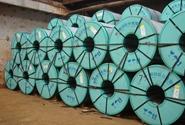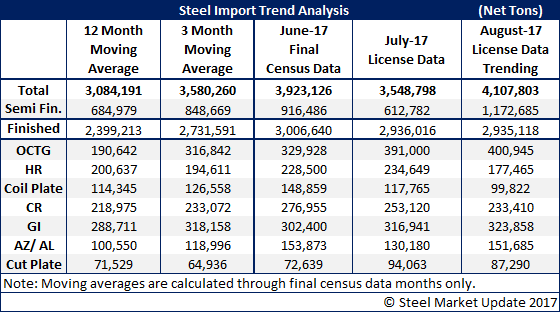Steel Products Prices North America

Foreign Steel Imports Still Flooding U.S.
Written by John Packard
August 17, 2017
The U.S. Department of Commerce released the latest license data for foreign steel imports for the month of August. Beginning in March 2017, imports have exceeded 3.0 million tons, perhaps peaking in June at just shy of 4.0 million tons. The expectation has been for import levels to drop due to concerns about the Section 232 investigation on steel, which began earlier this year. License data collected through Aug. 15 suggests the trend of higher than expected imports remains intact.
There are products that are surging despite antidumping and countervailing duty decisions against foreign producers.
The domestic steel mills are also very active, purchasing foreign-produced semi-finished steels (mostly slabs), which can only be used by the mills themselves. About 25 percent of total steel imports are slabs/billets going to the domestic mills for re-rolling and sale within the U.S.
When all is said and done, Steel Market Update expects August foreign steel imports will end the month close to the 3-month moving average of 3.5 million tons.

John Packard
Read more from John PackardLatest in Steel Products Prices North America

Nucor slows HRC price climb with $5/ton increase
After eight weeks of double-digit price increases on hot-rolled (HR) coil, Nucor slowed the price rise this week with an increase of $5 per short ton.

Domestic CRC prices surge ahead of imports
The price spread between stateside-produced CR and imports reached its widest margin in over a year.

Evraz raises plate prices $160/ton
Evraz North America (NA) has followed Nucor and SSAB with a plate price increase of its own: up $160 per short ton (st). The increase was effective immediately for all new orders of carbon, high-strength low-alloy, and normalized and quenched-and-tempered plate products, as well as for hot-rolled coil, the steelmaker said in a letter to […]

Nucor lifts HR coil to $820/ton
Nucor has increased its consumer spot price (CSP) for hot-rolled (HR) coil for a fourth consecutive week.

Nucor pushes HR spot price to $790/ton
Nucor increased its consumer spot price (CSP) for hot-rolled (HR) coil to $790 per short ton (st) on Monday, Feb. 10 – a $15/st bump vs. last week. The Charlotte, N.C.-based company has raised its weekly CSP by $40/st over the past three weeks after maintaining tags at $750/st since Nov. 12, according to SMU’s […]

